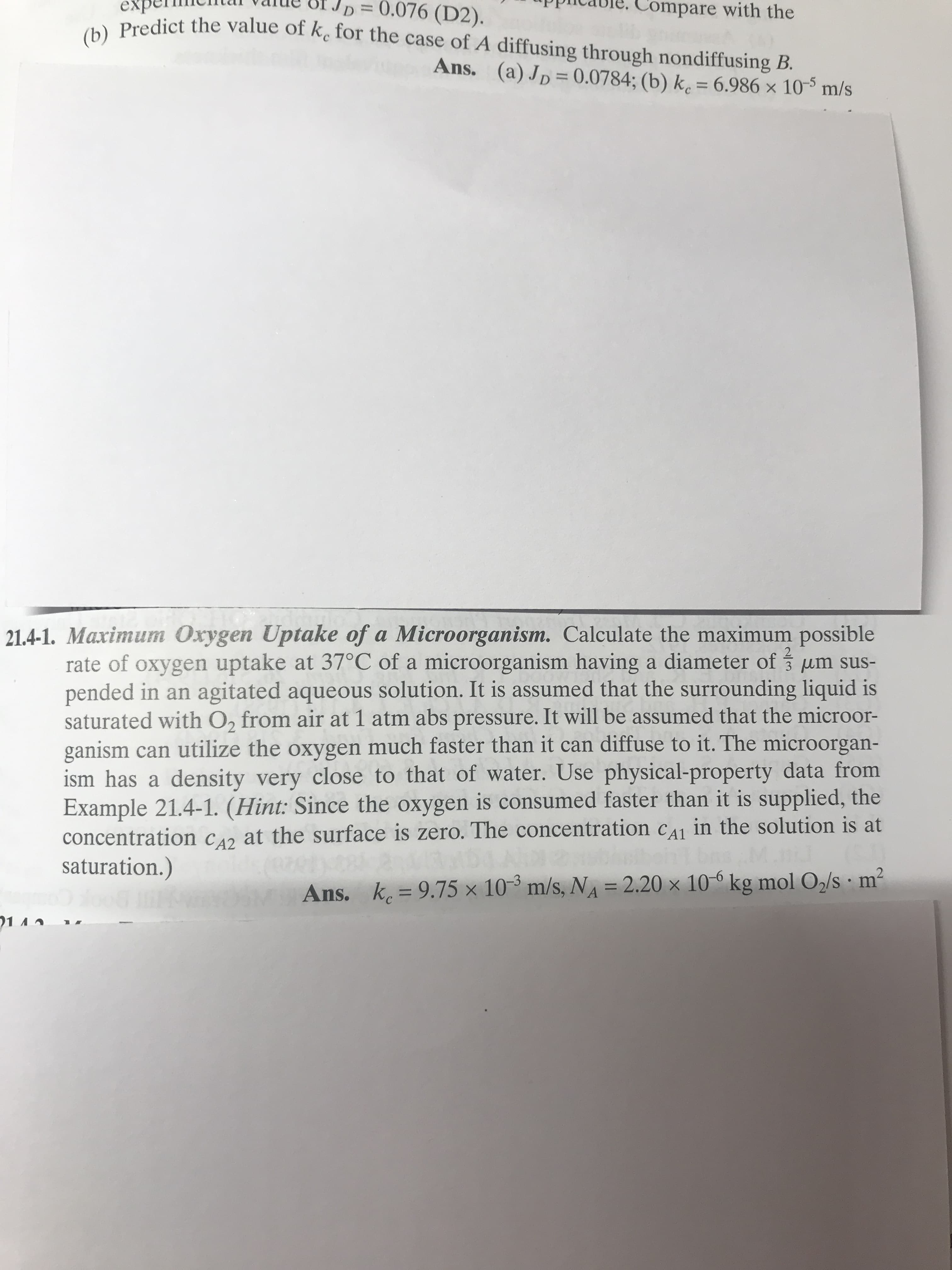0.076 (D2). Compare with the (b) Predict the value of ke for the case of A diffusing through nondiffusing B. Ans. (a) Jp0.0784; (b) k =6.986 x 103 m/s 21.4-1. Maximum Oxygen Uptake of a Microorganism. Calculate the maximum possible rate of oxygen uptake at 37°C of a microorganism having a diameter of um sus- pended in an agitated aqueous solution. It is assumed that the surrounding liquid is saturated with O2 from air at 1 atm abs pressure. It will be assumed that the microor- ganism can utilize the oxygen much faster than it can diffuse to it. The microorgan- ism has a density very close to that of water. Use physical-property data from Example 21.4-1. (Hint: Since the oxygen is consumed faster than it is supplied, the concentration CA2 saturation.) 2 at at the surface is zero. The concentration cA1 in the solution k= 9.75 x 10 m/s, NA 2.20 x 10- kg mol O2/s m2 Ans. 21 A
0.076 (D2). Compare with the (b) Predict the value of ke for the case of A diffusing through nondiffusing B. Ans. (a) Jp0.0784; (b) k =6.986 x 103 m/s 21.4-1. Maximum Oxygen Uptake of a Microorganism. Calculate the maximum possible rate of oxygen uptake at 37°C of a microorganism having a diameter of um sus- pended in an agitated aqueous solution. It is assumed that the surrounding liquid is saturated with O2 from air at 1 atm abs pressure. It will be assumed that the microor- ganism can utilize the oxygen much faster than it can diffuse to it. The microorgan- ism has a density very close to that of water. Use physical-property data from Example 21.4-1. (Hint: Since the oxygen is consumed faster than it is supplied, the concentration CA2 saturation.) 2 at at the surface is zero. The concentration cA1 in the solution k= 9.75 x 10 m/s, NA 2.20 x 10- kg mol O2/s m2 Ans. 21 A
Introduction to Chemical Engineering Thermodynamics
8th Edition
ISBN:9781259696527
Author:J.M. Smith Termodinamica en ingenieria quimica, Hendrick C Van Ness, Michael Abbott, Mark Swihart
Publisher:J.M. Smith Termodinamica en ingenieria quimica, Hendrick C Van Ness, Michael Abbott, Mark Swihart
Chapter1: Introduction
Section: Chapter Questions
Problem 1.1P
Related questions
Question

Transcribed Image Text:0.076 (D2).
Compare with the
(b) Predict the value of ke for the case of A diffusing through nondiffusing B.
Ans.
(a) Jp0.0784; (b) k =6.986 x 103 m/s
21.4-1. Maximum Oxygen Uptake of a Microorganism. Calculate the maximum possible
rate of oxygen uptake at 37°C of a microorganism having a diameter of um sus-
pended in an agitated aqueous solution. It is assumed that the surrounding liquid is
saturated with O2 from air at 1 atm abs pressure. It will be assumed that the microor-
ganism can utilize the oxygen much faster than it can diffuse to it. The microorgan-
ism has a density very close to that of water. Use physical-property data from
Example 21.4-1. (Hint: Since the oxygen is consumed faster than it is supplied, the
concentration CA2
saturation.)
2
at
at the surface is zero. The concentration cA1 in the solution
k= 9.75 x 10 m/s, NA 2.20 x 10- kg mol O2/s m2
Ans.
21 A
Expert Solution
This question has been solved!
Explore an expertly crafted, step-by-step solution for a thorough understanding of key concepts.
This is a popular solution!
Trending now
This is a popular solution!
Step by step
Solved in 4 steps with 3 images

Recommended textbooks for you

Introduction to Chemical Engineering Thermodynami…
Chemical Engineering
ISBN:
9781259696527
Author:
J.M. Smith Termodinamica en ingenieria quimica, Hendrick C Van Ness, Michael Abbott, Mark Swihart
Publisher:
McGraw-Hill Education

Elementary Principles of Chemical Processes, Bind…
Chemical Engineering
ISBN:
9781118431221
Author:
Richard M. Felder, Ronald W. Rousseau, Lisa G. Bullard
Publisher:
WILEY

Elements of Chemical Reaction Engineering (5th Ed…
Chemical Engineering
ISBN:
9780133887518
Author:
H. Scott Fogler
Publisher:
Prentice Hall

Introduction to Chemical Engineering Thermodynami…
Chemical Engineering
ISBN:
9781259696527
Author:
J.M. Smith Termodinamica en ingenieria quimica, Hendrick C Van Ness, Michael Abbott, Mark Swihart
Publisher:
McGraw-Hill Education

Elementary Principles of Chemical Processes, Bind…
Chemical Engineering
ISBN:
9781118431221
Author:
Richard M. Felder, Ronald W. Rousseau, Lisa G. Bullard
Publisher:
WILEY

Elements of Chemical Reaction Engineering (5th Ed…
Chemical Engineering
ISBN:
9780133887518
Author:
H. Scott Fogler
Publisher:
Prentice Hall


Industrial Plastics: Theory and Applications
Chemical Engineering
ISBN:
9781285061238
Author:
Lokensgard, Erik
Publisher:
Delmar Cengage Learning

Unit Operations of Chemical Engineering
Chemical Engineering
ISBN:
9780072848236
Author:
Warren McCabe, Julian C. Smith, Peter Harriott
Publisher:
McGraw-Hill Companies, The